Archive Entries for January 2016
« December 2015 | Main | February 2016 »
Sunday January 31, 2016
Books in January
- The Critic, Blacklight Blue, Freeze Frame, and, Blowback by
Peter May
So I chomped my way through the Enzo series - having had them in the queue for a while now. I was amused that he had lined up all his entourage with him in the second book - and then he third - so I thought I saw how it was all going. But in fact he threw off the formulaic shackles for the next two, which I think from a writing point of view was clearly a good move, (though personally I missed "the gang").
Now awaiting the 6th and apparently final book - which apparently covers both of the two final stories that are the premise for the series..
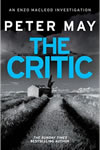
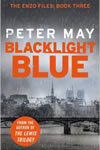
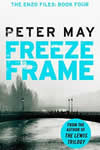
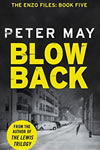
- Flesh Wounds by Christopher Brookmyre [read by Sarah
Barron]
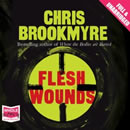
I dowloaded this from the library and then realised it was a sequel to Where the Bodies are Buried. This was "Good", barring the fact it's the third in a trilogy and I have not read the second one. That did not spoil the enjoyment though, and despite the fact that I read a few reviews which complain about the lack of realism in some of Brookmyre's work, I like the combination of humour and thriller, which in truth would be hard to achieve without some suspension of disbelief. [I also strongly agree with a review complimenting the author on his having several parallel plot threads that are properly woven together at the conclusion without any unduly forced contrivance]. 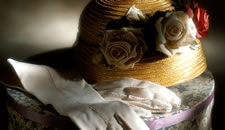 The Provincial Lady Goes Further
The Provincial Lady Goes Further
I have heard of E M Delafield's Provincial Lady - but that's about as far as it goes. Excellent reading by Claire Skinner of the sequel to the original novel (I missed the first one which appeared over Christmas). Given the slow gentle humour, I think maybe an abridged version is not perfect for these books, but delightful nonetheless.
I had a quick look at the works and life of the author and found that I have also read Thank Heaven Fasting, as reissued by Virago - very impressive in that I remember it very well - but not at all light hearted.... Sparkling Cyanide
Sparkling Cyanide
This is a charmingly dated story but has been produced in different settings over the years including by Agatha Christie's own hand in "Yellow Iris" - which is a Poirot short story pre-dating this novel. A notable 2003 update for TV gave us Pauline Collins and Oliver Ford Davies mysteriously playing some sort of elderly secret agents, and making George Barton (Kenneth Cranham) a football manager - complete rubbish but I admire the effort.
I digress. This seemed to stick to the original story featuring Colonel Race (Sean Baker) - which makes slightly more sense of the story line when kept in period. Hercule Poirot's Christmas
Hercule Poirot's Christmas
Two Poirots for the price of one. Astonished to see the famous detective played by none other than Peter Sallis! [Accent did tend towards Wallis from time to time].
Also Edward De Souza as Superintendent Sugden, Manning Wilson as Colonel Johnson, Cyril Luckham as Simeon Lee, Rachel Gurney as Lydia Lee, (good old) Nicky Henson as Harry Lee, Deborah Makepeace as Pilar Estravados, and (dear old) Deryck Guyler as Tressilian, the butler.
From the book first published in 1938 and dramatised by Michael Bakewell in 1986.
Murder in Mews(1955)
A production from the Light programme in 1955 - thought to be lost but redisovered last year. Stars Richard Williams as Hercule Poirot, Ian Whittaker as Freddie Hogg, Jack Melford as Chief Inspector Japp, Ronald Sidney as Detective-Sergeant Jameson, Duncan McLntyre as Doctor Brett, Monica Grey as Jane Plenderleith and Ella Milne as Mrs Hogg.
[ Dramatised by Anthony Aspinall from a short-story first published in Woman's Journal in 1936, which later appeared in a book collection in 1937]
Posted on January 31, 2016 at 10:09 AM. Category: Books of the Month.
Saturday January 30, 2016
The Age of Aquarius
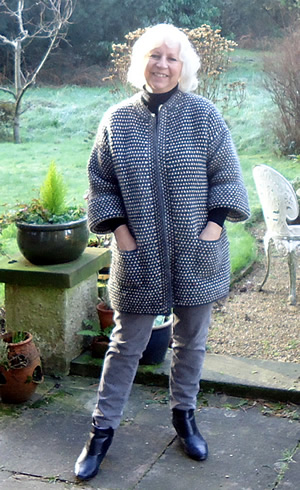
I never realised how much I was a child of the seventies (ok - "young adult") until the recent fashion surge towards ... I'm not sure towards what actually .... I don't really remember embracing the seventies fashion at the time, but whatever is going on now is clearly having it's effect on me.
[OK - I am not deluded into thinking that the above photo shows me in the most flattering garment I have ever worn - but I do love it!]
At first I noticed that almost all my old magazines of the period have
apparently relevant patterns in them - I never had so many potential candidates
for "Pattern of the Month", especially not so many that are actually wearable
right now. Of course the styling is a bit laughable, but ridiculing our
former fashion mistakes seems to be ..... fashionable. (I have to come
clean here and say I don't altogether approve; I read an apposite quote
once about not trying to appear wise by mocking our younger selves, and
it struck a chord as I think I did it all the time.)
Next, I realised that not only did I have a lot of candidates for POM
but I wanted to knit them all myself! This is a daunting prospect for
one such as I with so much knitting in progress already - but nonetheless
I metaphorically girded my loins and set forth with my needles (and yarn)
on a voyage of New Age (or possibly Old Age) discovery.
The result is that I have adapted a good example of a pattern that looks
pretty dubious because of its styling but is really just a simple wrap
shape for a "blanket coat" (noting that old people like blankets ... so
... perfect for me in every way).
Below ("read more") are the notes on what I did and I have posted the full original pattern
as the January 2016 entry on POM.
Pattern Notes for the Coatigan
The original pattern is for a "thickish" double knitting yarn - possibly an American worsted weight - knitted as stripes all in garter stitch. It's a tweedy marl yarn and produces a good effect just as written. The sizing is for men, but goes down to a 38 inch chest - so for a big cosy blanket effect should be ok for many women.
I wanted to copy the kind of coatigan I have seen commercially available
at the moment - both in colour and texture, which would be black/grey
tweeds. In fact, were I a weaver I might have been tempted to try and
weave the garment, as it is mainly made up of rectangular segments. However
I am not - so back to reality.
I wanted to use yarn I already had, and it needed to be something I had
a lot of. Thus back to my old favourite: Sirdar Peru, which is a discontinued
yarn. I have a lot of the colour "Tailor" - a grey/black - but decided
it was not tweedy enough, so I worked a tweedy stitch, combining it with
the cream colour Llama. (Note here that if you decide to knit - your sister
for example - a chunky sweater for Christmas in lovely creamy Sirdar Peru
in Llama - it is a "graduated" yarn and in Llama this means it
looks like it is a cream sweater where someone has accidentally spilled
tea on it during the knitting process. It is not quite so noticeable or
unappealing in the other colour options....).
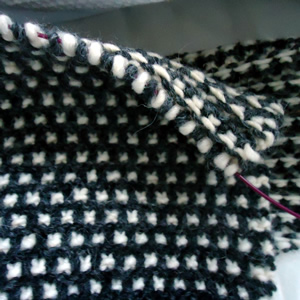
The stitch I used was "almost" garter stitch. Every row is
purl, and you slip some stitches on some of the rows, which creates the
pattern. Do not be tempted to decide after you have knitted several inches
that: "I've had enough of this purl stuff and why aren't I just doing
it knitwise in any case as it's just the same?" - because, while
it is just the same, the tension is massively different, and you
will knit 20 inches of the back only to discover that your knitting made
a step change and lost 2 whole inches in width. (Ask me how I know). If
you set out from the start by knitting all knitwise you will need to compensate
by checking your tension against the size you intend to knit.
So - enough preamble - here are
the pattern rows - worked over an odd number of stitches.
1st row (right side facing):
Purl in main colour. Leave main colour hanging.
2nd row: Join in contrast colour,
purl 1, with wool at front, * slip
1, purl 1; repeat from * to end.
3rd row: Continuing with contrast
colour only, purl 1, put wool to back of work, *
slip 1, bring wool forward, purl 1; repeat from *
to end, and leave contrast colour hanging.
4th row: Pick up main colour
again and purl across all stitches
5th row: Purl across all stitches
in main colour.
6th row: Pick up contrast colour
again, purl 2, with wool at front, *
slip 1, purl 1 ; repeat from * to
last stitch, purl 1.
7th row: Continuing with contrast
colour as before, purl 2, put wool to back of work, *
slip 1, bring wool forward, purl 1; repeat from *
to last stitch, purl 1.
8th row: Purl in main colour.
These 8 rows form pattern. You can choose the light colour for the main
and dark as contrast or vice versa. My version has the dark colour as
the main colour. You can also produce a nice effect by reversing the colours
after every 8 row repeat, or by knitting several sets of the 4 rows and
then reversing. I experimented by starting with the main colour dark,
and knitting one set of 8 rows and then the first row again in dark, I
then knitted 2 rows purl in light, and the next 8 rows (2- 8 then the
1st again) reversing the colours with my main colour being light... and
so on .. bounding each set in 2 extra rows of purl garter stitch. You
could change every set of 4 pattern rows by inserting 2 extra rows between
rows 5 and 6 for narrower stripes.
This really is a very adaptable stitch - and very easy to execute.
Having got back on track and choosing to stick with the purl version as written, the fabric it produced is lovely. A sort of cosy double thickness where I actually love the wrong side of the knitting easily as much as the right side. It's firm while also squashy, so it keeps its boxy shape - but not too much. Sirdar Peru is not pure wool (60% wool/alpaca) but it is lovely and soft and... blankety.
Which brings me to probably the most important point about the sizing.
Sirdar Peru is not a double knit or a worsted weight yarn, but a chunky.
It is a thinnish chunky, even though the standard tension of 14 stitches
to 10cm or 4 inches puts it firmly in the chunky range if you use the
right needles. I used 5mm needles and made a swatch using my pattern stitch,
and came up with just about the actual tension stated in the Blanket Coat
pattern - 18 stitches by 32 rows to 4 inches. In fact the number of rows
was not quite right but easily fixed by knitting it to whatever length
you want for the coat - which in my case I wanted to be a bit smaller
than the man's length given in the pattern in any case. So I ploughed
right ahead and made my pieces using the smallest 38 inch size (I am generally
a size 12 with a 36-38 inch chest) an adding 4 extra stitches to the 2
front pieces.
Having tried it on, it certainly fitted well - but more like a conventional
cardigan than a capacious coatigan, so I moved to plan B. I inserted vertical
stripes of the pattern at the sides and the front borders increasing the
size to about 40 inches - I had always thought this might be a nice decorative
feature and it became a useful strategy. The sleeves were easy to fit
either straight as intended or with a tiny part of the side seam to attach
to the underarm insert.
Voilà.
The original pattern has patch pockets - I chose to add conventional "insert" pockets sewn down on the inside.
A short note on picking up stitches for the front band and the sleeves:
Using this pattern stitch, I picked up 2 stitches for every 4 rows to make the side panels and the front bands. [By comparison with stocking stitch where you might pick up 2 stitches for every 3 rows].
I also did this when knitting the sleeves - I picked up about 92 stitches equally spaced around the shoulder seam, and knitted the sleeves downwards so I could choose how long to make them. I did adapt the pattern here slightly to reduced the sheer volume of the sleeves, which was a bit overwhelming in chunky weight with this stitch.
I began by knitting 8 pattern rows then I decreased one stitch at each every 16th row (2 patterns) 10 times, leaving 72 stitches. I knitted to the length I wanted the sleeve, then I reversed the knitting (by knitting extra plain purl rows in the main colour) before setting off with the pattern again - this allows the cuff to turn back without the wrong side of the knitting being on show.
Posted on January 30, 2016 at 2:48 PM. Category: Knitting and Crochet.
Friday January 29, 2016
Under the Bridge

Rob got tickets to see Cheikh Lô "Under the Bridge". He was great.
It's a lovely venue (and a fantastic musician) yet surprisingly the tickets were not all sold out. However there were plenty of people there to give a good atmosphere while also allowing breathing to take place.
Various websites seem to be all over the place in suggesting who the support act might be - wishfully writing "Robert Randolph", (which would have been good, though unlikely).
However it was Randoph Matthews - a "vocal entertainer" - and he surely was.
Posted on January 29, 2016 at 11:11 PM. Category: Art and Culture.
Friday January 8, 2016
More Christmas Furbelows

So here is my January "Home Made Christmas" - making a few extra items for next year - as there is never any time to play in the run-up to the festive season.
I saw a lovely fun banner saying FALALALA! on WIT's website - she did say it was not available at the time but in fact I did find a source for it - but by then I had decided to make one myself!
This was not really a good decision even though I had a lot of fun. It involved a lot of techniques (specifically glueing glitter!) that I have not tried much before. Technology has moved on but I still ended up with glitter appearing everywhere - in and out of the house - long after I had "completely" cleared up. [At at £1 per letter, it also cost me a lot more than just buying the banner would have done - but where's the fun in that?]
I had some left over lower case letters - so I also made another banner in bright red saying "joy". For FALALALALA I painted the letters in white emulsion paint (not so good a decision), and glued gold to the top surface and white ("snow" glitter) on the sides. For JOY, I used an undercoat of a red stain and then 2 coats of "glitter glue" - which has produced a nice effect - and less mess. I think glitter glue would work best making fine lines of glitter on cards etc - less adapted for large flat surfaces.
And finally - Alison sent me this lovely picture of a previous year's furbelows in the perfect setting at her "cabin in the woods".
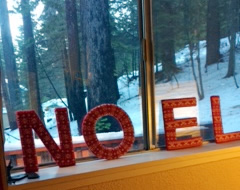
Posted on January 8, 2016 at 8:12 PM. Category: Crafts.
